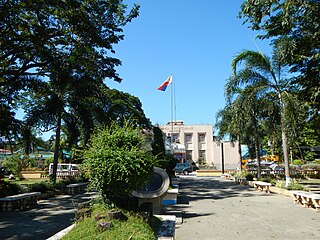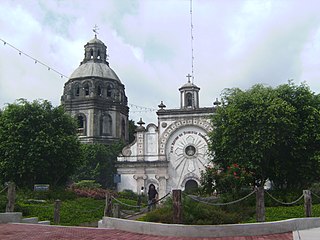
The Katipunan, officially the Kataastaasan Kagalang-galang na Katipunan ng mga Anak ng Bayan(lit. 'Supreme and Honorable Association of the Children of the Nation'; Spanish: Suprema y Honorable Asociación de los Hijos del Pueblo) and abbreviated as the KKK, was a revolutionary organization founded in 1892 by a group of Filipino nationalists Deodato Arellano, Andrés Bonifacio, Valentin Diaz, Ladislao Diwa, José Dizon, and Teodoro Plata. Its primary objective was achieving independence from the Spanish Empire through an armed revolution. It was formed as a secret society before its eventual discovery by Spanish authorities in August 1896. This discovery led to the start of the Philippine Revolution.

Pampanga, officially the Province of Pampanga, is a province in the Central Luzon region of the Philippines. Lying on the northern shore of Manila Bay, Pampanga is bordered by Tarlac to the north, Nueva Ecija to the northeast, Bulacan to the east, Manila Bay to the central-south, Bataan to the southwest and Zambales to the west. Its capital is the City of San Fernando. Angeles City is the largest LGU, but while geographically within Pampanga, it is classified as a first-class, highly urbanized city and has been governed independently of the province since it received its charter in 1964.

Candaba, officially the Municipality of Candaba, is a 1st class municipality in the province of Pampanga, Philippines. According to the 2020 census, it has a population of 119,497 people.

Apalit, officially the Municipality of Apalit, is a 1st class municipality in the province of Pampanga, Philippines. According to the 2020 census, it has a population of 117,160 people.

The Philippine Revolution was a war of independence waged by the revolutionary organization Katipunan against the Spanish Empire from 1896 to 1898. It was the culmination of the 333-year colonial rule of Spain to the archipelago. The Philippines were among the last colonies of the Spanish Empire, which saw a massive decline particularly in the 1890s. Cuba rebelled in 1895, and the empire soon fought against the United States in a war that they lost. In June 1898, Philippine revolutionaries declared itself a republic. However, this was not recognized by Spain, which sold the islands to the United States in the Treaty of Paris.

Bacolor, officially the Municipality of Bacolor, is a 3rd class municipality in the province of Pampanga, Philippines. According to the 2020 census, it has a population of 48,066 people.

Guagua, officially the Municipality of Guagua, is a 1st class municipality in the province of Pampanga, Philippines. According to the 2020 census, it has a population of 128,893 people.

Macabebe, officially the Municipality of Macabebe, is a 1st class municipality in the province of Pampanga, Philippines. According to the 2020 census, it has a population of 78,151 people.

Masantol, officially the Municipality of Masantol, is a 2nd class municipality in the province of Pampanga, Philippines. According to the 2020 census, it has a population of 57,990 people.

Sasmuan, officially the Municipality of Sasmuan, formerly known by its Spanish name Sexmoán, is a 4th class municipality in the province of Pampanga, Philippines. According to the 2020 census, it has a population of 29,076 people.

Calumpit, officially the Municipality of Calumpit, is a 1st class municipality in the province of Bulacan, Philippines. According to the 2020 census, it has a population of 118,471 people.
The Kapampangan people, Pampangueños or Pampangos, are the sixth largest ethnolinguistic group in the Philippines, numbering about 2,784,526 in 2010. They live mainly in the provinces of Pampanga, Bataan and Tarlac, as well as Bulacan, Nueva Ecija and Zambales.

Joaquín González was a Filipino politician and a member of the Malolos Congress that wrote the Malolos Constitution, the first Philippine constitution, after the country declared independence from Spain in 1898. He was one of two elected delegates representing the province of Pampanga, the other being José Rodríguez Infante. Along with Felipe Calderón y Roca, the main author of the constitution, Dr. González was on a committee that debated over each article of the charter from October 25 to November 29, 1898.

Kapampangan cuisine differed noticeably from that of other groups in the Philippines. The Kapampangan kitchen is the biggest and most widely used room in the traditional Kapampangan household. When the Philippines was under Spanish rule, Spanish friars and sailors taught Kapampangans the basics of Spanish cooking. The Kapampangans were able to produce a unique blend that surprised the Spanish palate. Soon Spanish friars and government officials were entertaining foreign guests at the expense of Kapampangan households. In the late 18th century, the Arnedo clan of Apalit were commissioned by the colonial government to entertain foreign dignitaries that included a Cambodian prince and a Russian archduke. Kapampangans were given the task of creating the meal and menu that was served in the proclamation of the First Philippine Republic in Malolos, Bulacan.
Bulacan is a province of the Philippines. It was established on 15 August 1578.
Felipe Salvador, also known as Apo Ipe or Ápûng Ipê Salvador, was a Filipino revolutionary who founded the Santa Iglesia, a messianic society that was categorized as "colorum" which had the aim of defeating and overthrowing the occupational government of the United States in the Philippines. Salvador joined the Katipunan in 1896 upon the arrival of the Katipuneros from Balintawak in Baliuag, Bulacan. He founded the Santa Iglesia in 1901 after fleeing to the mountains when Gen. Emilio Aguinaldo was captured by American troops. Salvador and his church gained a significant number of followers in the regions of Bulacan, Pampanga, Pangasinan, Tarlac and Nueva Ecija. He was captured by American forces in 1910. He was tried and sentenced to death, being hanged in 1912, two years after his capture.

Apung Mamacalulu or the Santo Entierro of Angeles City, is a statue depicting the burial of Jesus Christ and is enshrined at the Archdiocesan Shrine of Christ our Lord of the Holy Sepulchre in Lourdes Sur, Angeles City in the Philippines. Thousands flock to hear the special Holy Mass celebrated every Friday at the shrine.

Aurelio Tolentino y Valenzuela was a Filipino playwright, poet, journalist, and revolutionary. His works at the turn of the 20th century depicted his desire to see Philippine independence from its colonizers. He was arrested twice, first by the Spaniards and later by American forces. He wrote and directed the anti-imperialist play Kahapon, Ngayon at Bukas, which led to his arrest in 1903.

The Battle of Manila of 1896 occurred in Manila in the Spanish colony of the Philippines during the Philippine Revolution. Katipunan under Andres Bonifacio attempted to take the city but the attempt failed, and Bonifacio retreated to the city's outskirts. The Battle of San Juan del Monte was joined a day later when Bonifacio attempted to capture the San Juan's powder magazine, but this too failed.

The Battle of Sambat was the culminating battle of the first revolts of the Katipunan in Laguna. The battle was the final major action for the Katipunan chapter of "Maluningning" ending in the defeat of the rebels and martial law in Laguna province.



















